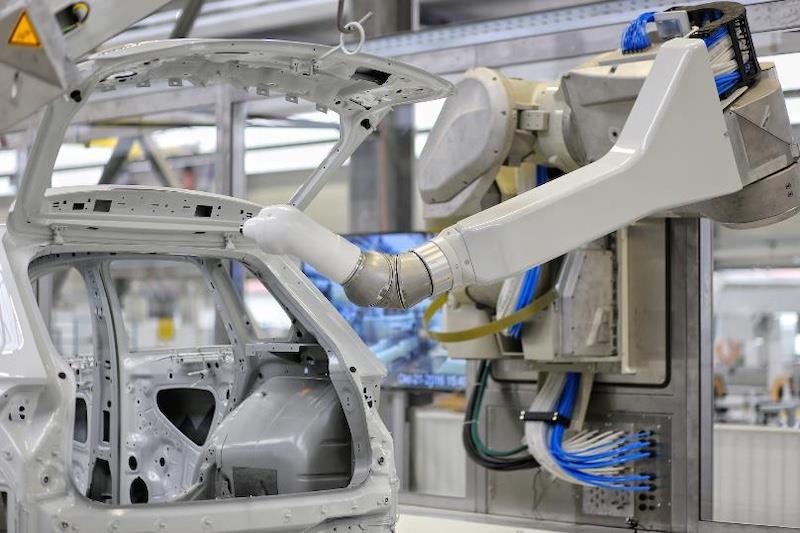Dürr Builds Low-Emission Automotive Paint Shop For Volkswagen Plant In Mexico
September 2, 2025 by Mai Tao
Dürr has built a paint shop designed to slash CO2 emissions at one of the Volkswagen Group's largest manufacturing facilities. The plant in Puebla, Mexico, was inaugurated in January 2025.
The turnkey project includes two identical painting lines that are particularly environmentally friendly due to their electrified equipment, such as the electric drying system.
Dürr is also implementing key components of its new“Paint Shop of the Future” concept with a high-bay warehouse and driverless transport systems.
Since January 2025, the Puebla Volkswagen plant paints 90 vehicle bodies per hour of different models. Dürr was awarded the contract in 2022. The innovative paint shop is engineered to seamlessly accommodate additional models and emerging future technologies.
This adaptive capability aligns with the high-output nature of the production plant and is made possible by a central high-bay warehouse and the EcoProFleet driverless transport system.
DXQ software controls the AGV (automated guided vehicle) developed specifically for paint shops that predictively sorts the bodies in combination with the high-bay warehouse and brings them to the right work deck or collects them with pinpoint accuracy.
Dividing rigid production lines is a central tenet of Dürr's“Paint Shop of the Future” concept and shortens the overall process by tailoring the process time exactly to the individual vehicle. This fact alone significantly reduces overall CO2 emissions.
Painting technology for high model varianceThe two identical painting lines feature 170 sealing and painting robots, with the corresponding application technology for sealing and coating the different Volkswagen models in the future.
This encompasses EcoRS Clean F, a prime example of Dürr's efforts to bolster system technology to equip it for growing model diversity.
It combines the thorough, gentle cleaning prowess of a feather roller system with the high flexibility inherent to a robotic setup. This makes it perfect for lines that paint many body variations with complex contours.
The contract scope also includes the complete paint and PVC supply and software solutions with AI applications from Dürr's proprietary DXQ product family.
Substantial reduction in CO2 emissionsA central factor in CO2 emissions reduction is body drying since it consumes the most energy in the painting process.
Operating the ovens with regenerative energy, like green electricity, reduces the CO2 emissions from the overall system by around 40 percent compared to a paint shop using natural gas.
Bruno Welsch, COO automotive at Dürr, says:“This was one of the reasons why Volkswagen opted for the EcoInCure electric drying system.
“Another is its special air duct system that heats the bodies from the inside out. This technology results in more uniform heating and cooling behaviour and reaches solid body components like the rocker panels more directly than conventional systems, cutting the body heating times by 30 percent.”
Electric package concept for oven and exhaust air purification
Another cornerstone for minimising CO2 emissions is linking the electric oven to an electric air pollution control system. Dürr is the only provider on the market with an overall blended concept of this kind.
It combines the EcoInCure with an X, an electric exhaust air aftertreatment system that purifies the polluted exhaust air using the principle of regenerative thermal oxidation (RTO) – with no open flame.
Unlike conventional combustion processes, no additional CO2 is produced by the operation. The system is also extremely energy efficient and achieves autothermal operation even with small quantities of solvent, that is, it maintains its operating temperature by itself.
It uses the significant energy produced during oxidation of the solvents to keep its process going.
Dürr has also installed an energy-saving, environmentally friendly system for overspray separation. EcoDryScrubber uses limestone powder as a natural binder to separate paint overspray. Highly efficient HEPA12 filters remove all particles from the process air.
The saturated limestone powder is disposed of fully automatically via a piping system – with no process interruption.
The dry separation system at Volkswagen Puebla minimises the required fresh air supply to 5 percent maximizing the proportion of recirculated air.
This reduces the paint booth's energy consumption by well over 60 percent compared with wet scrubbing.
Legal Disclaimer:
MENAFN provides the
information “as is” without warranty of any kind. We do not accept
any responsibility or liability for the accuracy, content, images,
videos, licenses, completeness, legality, or reliability of the information
contained in this article. If you have any complaints or copyright
issues related to this article, kindly contact the provider above.
Most popular stories
Market Research

- United States Lubricants Market Growth Opportunities & Share Dynamics 20252033
- UK Digital Health Market To Reach USD 37.6 Billion By 2033
- Immigration Consultancy Business Plan 2025: What You Need To Get Started
- United States Animal Health Market Size, Industry Trends, Share, Growth And Report 2025-2033
- Latin America Mobile Payment Market To Hit USD 1,688.0 Billion By 2033
- United States Jewelry Market Forecast On Growth & Demand Drivers 20252033






















Comments
No comment